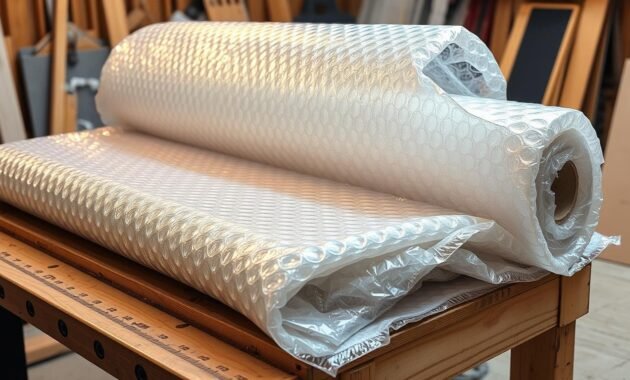Is your shed turning into a temperature nightmare? Extreme heat and cold can damage your tools and stored items. Cold winters and hot summers can harm expensive equipment, leading to costly replacements.
Most homeowners don’t know that 40% of shed heat loss happens through the roof. This creates uncomfortable and potentially damaging environments.
Learning to insulate a shed for free is more than just saving money. It’s a smart way to protect your belongings. I’ll show you five creative ways to insulate your shed for free. This will make your shed a comfortable and safe place for your valuable items.

Get ready to find affordable solutions that will change your storage space. You won’t need to spend a dime on expensive materials!
Why Your Shed Needs Proper Insulation
Keeping your shed insulated is more than a simple task. It’s a smart move to protect your tools, equipment, and storage. It can save you money and keep your belongings in good shape.
Sheds often get ignored when it comes to keeping them cool or warm. Without insulation, they’re exposed to harsh weather. This can harm your items and raise your energy bills.
Understanding Heat Loss in Sheds
Sheds lose heat through walls, roofs, and floors. This makes them bad places for sensitive stuff. The right insulation can stop this heat loss.
- Uninsulated sheds lose up to 35% of their internal heat
- Metal roofs are prone to condensation and temperature changes
- Poor insulation can cause moisture and mold
Read also: How to Overcome Leaking Metal Roof
Benefits of Insulated Storage Spaces
Insulating your shed can change it into more than just a storage spot. It can become a workshop, hobby area, or even an extra living space.
| Insulation Type | R-Value | Cost Estimate |
|---|---|---|
| Mineral Wool | R-15 | $426.37 |
| Fiberglass Batt | R-19 | $231.83 |
Cost Savings Over Time
Insulating your shed might cost a bit at first. But, it saves a lot of money in the long run. It keeps your shed at a steady temperature, saving on heating and cooling costs. Plus, it protects your items from damage.
- Potential energy savings of up to 20% annually
- Protection for temperature-sensitive tools and equipment
- Extended usability of your shed throughout the year
Preparing Your Shed for Insulation
Before starting your diy shed insulation, let’s cover the key preparation steps. A well-prepared shed is key for efficient insulation. It will protect your shed better.
Start by inspecting your shed carefully. Look for damage, moisture, or pest entry points. Fix these issues before you insulate to avoid future problems.
- Check for roof leaks or water damage
- Inspect walls for cracks or gaps
- Examine floor for moisture or rot
- Verify structural integrity of framing
Cleaning is a must before insulating your shed. Clear out everything and clean it well. Sweep away dust and debris. Use a mild bleach solution for mold or mildew.
Good ventilation is important for your insulated shed. Make sure it has enough air flow to avoid moisture. You might need vents or a ventilation system to control temperature and humidity.
- Install soffit vents
- Add ridge vents
- Use small gable vents
- Consider a small exhaust fan
Measuring your shed is vital for the right insulation. For a 10 by 12 feet shed, calculate the square footage of walls, ceiling, and floor. This will help you figure out how much insulation you need.
Read also: How to Clean Soffit Vents from Aluminum and Vinyl Materials
How to Insulate a Shed for Free: Understanding Your Options
Insulating a shed can be done without spending money. You can use free materials to keep your storage space warm. I’ve found ways to do this using things you might already have.
Insulating a shed needs planning and knowing what free materials are available. You want to block out temperature changes without spending much.
Assessing Available Materials
Start by looking around your home for free materials. Some great options include:
- Cardboard boxes from shipping packages
- Old newspapers and magazines
- Bubble wrap from packaging
- Used blankets or rugs
- Styrofoam sheets from electronics packaging
Safety Considerations
When working with free insulation, safety is key. Always wear:
- Safety glasses
- Work gloves
- Dust mask
- Long-sleeve clothing
Tools You’ll Need
Before you start, get these basic tools:
- Utility knife
- Measuring tape
- Staple gun
- Scissors
- Adhesive or tape
With these free materials and the right techniques, you can insulate your shed for free. Being creative and strategic is the secret to success.
Using Cardboard as an Effective Insulator
Insulating a shed for free is possible with cardboard. It’s a material often overlooked but very practical. To insulate a shed for free, you need to know how to prepare and apply cardboard.
For free insulation, look for cardboard boxes from local businesses or recycling centers. Flat, clean cardboard is best for insulation. Collecting multiple layers can increase thermal resistance.
- Check cardboard for cleanliness and structural integrity
- Remove tape and staples completely
- Flatten boxes to create smooth insulation panels
- Overlap edges to minimize heat transfer
Cardboard’s structure traps heat well, making it effective for insulation. I found that using multiple layers can greatly reduce heat loss.
| Cardboard Insulation Factor | Performance Rating |
|---|---|
| Thermal Resistance | Moderate |
| Cost | Free |
| Ease of Installation | High |
| Moisture Vulnerability | High – Requires Protection |
To get the best results, seal cardboard panels with non-toxic adhesive. Then, cover them with plastic sheeting to prevent moisture damage. This boosts insulation performance.
Keep in mind that cardboard insulation isn’t permanent. You’ll need to check it regularly and replace it as needed. This ensures your shed stays well-insulated.
Recycled Newspaper: A Traditional Insulation Method
Insulating your shed doesn’t have to cost a lot. Using recycled newspaper is a smart, free way to keep your shed cozy. This old-school method helps your shed stay at a comfortable temperature, using materials you might toss out.
Newspaper can be a great insulator if you do it right. The trick is to turn these free items into a good thermal barrier. This barrier helps control your shed’s temperature.
Preparing Newspaper for Insulation
To make newspaper insulation work, you need to prepare it well. Here’s what to do:
- Get dry, clean newspapers without glossy pages
- Take out staples, plastic sleeves, and other non-paper stuff
- Shred or tear the papers into the same size pieces
- Mix shredded paper with borax to make it fire-resistant
Installation Techniques
Here’s how to put newspaper insulation in your shed:
- Make dense paper batts by squishing shredded newspaper
- Use wire mesh or fabric to keep the insulation in place
- Make sure to cover all walls and the ceiling
- Stuff the newspaper tightly to get the best insulation
Moisture Prevention Tips
Stopping moisture is key when using paper insulation. Here’s how to do it:
- Put a vapor barrier on before adding the newspaper insulation
- Make sure your shed has good air flow
- Check the insulation often for dampness
- Think about using waterproof sealant for extra protection
By using these tips, you can make recycled newspapers into a cheap, yet effective insulation for your shed.
Bubble Wrap Insulation: Collection and Application

Bubble wrap might seem like an odd choice for insulation, but it works well. The air pockets in bubble wrap act as a thermal barrier. This helps keep your shed warm and stable in temperature.
Finding bubble wrap is simpler than you think. Just ask local businesses, packaging companies, and online sites. Many toss out bubble wrap and are glad to give it away for free.
- Check with local electronics stores
- Contact shipping and packaging companies
- Browse online marketplaces like Craigslist
- Ask friends and neighbors who receive frequent shipments
To get the most out of bubble wrap, clean the shed walls first. Then, use clear tape to stick it on, making sure the bubbles are inside. This helps trap heat better.
| Bubble Wrap Insulation Characteristics | Details |
|---|---|
| Cost | Free or Low-Cost |
| Insulation Efficiency | Moderate (Traps heat in air bubbles) |
| Installation Difficulty | Easy |
| Durability | Limited (May need replacement over time) |
Bubble wrap isn’t the top choice for insulation, but it’s cheap. Adding more layers can make it even better. So, feel free to stack your bubble wrap pieces.
Repurposed Fiberglass Materials for Shed Walls
Insulating your shed with fiberglass can make it more efficient and comfortable. Fiberglass roll materials are an affordable way to keep walls and ceilings at a steady temperature.
Looking for free fiberglass insulation? Check out construction sites, renovation projects, and local building supply stores. They often have leftover materials for your shed.
Safety First: Handling Fiberglass Insulation
Working with fiberglass needs careful preparation. Always wear protective gear to avoid skin irritation and breathing problems:
- NIOSH-certified N95 respirator
- Long-sleeved clothing
- Thick work gloves
- Safety glasses
Installation Techniques for Walls and Ceiling
Proper installation of fiberglass insulation is key for good thermal performance. Most wood-framed sheds need 3-1/2 inch thick insulation with an R-value of R-13 or R-15.
Here’s how to install fiberglass insulation in your shed walls and ceiling:
- Measure wall cavities (typically 16 or 24 inches on-center)
- Cut fiberglass roll to match cavity dimensions
- Gently press insulation into wall spaces without compressing
- Secure with staple gun if using faced insulation
- Add vapor barrier on warm side of insulation
By repurposing fiberglass insulation, you can make a well-protected shed. It will keep temperatures steady and protect your items from harsh weather.
Natural Materials for Eco-Friendly Insulation
Looking for free insulation for your shed? Natural materials are a great, eco-friendly choice. They keep your space cozy without costing much.
I’ve found some organic options that are both free or cheap. They not only keep your shed warm but also help the planet.
- Straw: An abundant agricultural byproduct with excellent insulating properties
- Leaves: Collected autumn leaves can create effective barrier against heat loss
- Sawdust: Wood processing waste that provides surprising thermal protection
- Wood chips: Free material from local tree services or woodworking shops
Getting ready is important when using these materials. Make sure they’re dry to avoid moisture problems. Pack them tightly to fill all gaps.
| Natural Material | R-Value (per inch) | Availability |
|---|---|---|
| Straw | 1.4 – 1.8 | High (agricultural regions) |
| Sawdust | 2.0 – 2.5 | Medium (woodworking areas) |
| Leaves | 1.2 – 1.6 | High (seasonal) |
When working with these materials, safety first. Wear gloves and a dust mask. Also, check for pests and seal well to avoid moisture.
Pro tip: Blend different natural materials for better insulation. This creates a stronger thermal barrier for your shed.
Installing Your Chosen Insulation Material
Choosing the right insulation for your shed is key. It needs careful planning and precise steps. I’ve learned that the right installation keeps your storage space comfy.
Start by getting all your materials ready and clearing your workspace. The process has several important steps for the best results.
Wall Installation Guide
Here’s how to insulate your shed walls:
- Measure each wall section carefully (they’re about 9 feet tall)
- Cut insulation batts to fit between studs, which are 16 inches apart
- Use R-13 batts, covering 116 square feet per package
- Make sure the insulation fits snugly, with no gaps
Ceiling Application Tips
Insulating your ceiling needs special care for good airflow:
- Install rafter baffles to keep air flowing
- Use R-30 insulation for the best heat protection
- Place soffit vents about every 24 inches
- Think about using 6-mil plastic sheeting as a vapor barrier
Sealing Gaps and Corners
Sealing well is vital for good insulation. Keep 2-3 boxes of staples handy. Addressing small openings carefully helps prevent heat loss and boosts comfort.
Maintaining Your DIY Insulation
After you finish your diy shed insulation project, keeping it up is key. Regular care helps your insulation work well for a long time. It also keeps your storage space safe from problems.

Keeping your shed’s insulation right is easy. I’ll show you simple ways to keep it in great shape.
Creating a Regular Inspection Schedule
Make a plan to check your insulation often. This will help you keep your investment safe. Here’s a good schedule:
- Check for moisture or damage every quarter
- Do a full insulation check every six months
- Clean and fix insulation once a year
Addressing Common Insulation Issues
Each insulation type needs special care. You might face:
- Moisture buildup
- Pests getting in
- Insulation getting compressed or settling
- Mold growing
Prevention and Quick Fixes
To keep your shed warm and cozy, follow these tips:
- Seal any gaps or cracks right away
- Use barriers that stop moisture
- Look for signs of rodents
- Fix damaged insulation fast
By following these steps, your diy shed insulation will last longer. It will also keep your space warm all year.
Common Mistakes to Avoid When Insulating Your Shed
When trying to insulate a shed for free, I’ve found some big mistakes. These mistakes can ruin your DIY project. They can also damage your shed.
Choosing the right insulation material is important. Many people make mistakes that make insulation less effective.
- Neglecting moisture barriers, which can lead to mold and structural damage
- Leaving gaps or uneven coverage in insulation layers
- Using wet or contaminated recycling materials
- Compressing insulation materials, reducing their thermal resistance
- Failing to seal air leaks before installation
Proper preparation is essential. The Environmental Protection Agency says homeowners can save up to 20% on heating and cooling by insulating well.
When using free materials like cardboard or recycled fiberglass, check them first. Look for moisture, pest damage, or weakness. Wearing protective gear helps keep you and the insulation safe.
It’s tempting to cut corners when insulating for free. But, precise installation is more important than the cost. A poorly insulated shed can attract moisture, pests, and lose energy.
- Check materials for cleanliness before use
- Create a complete vapor barrier
- Ensure consistent coverage
- Seal all possible air leak points
The aim of your DIY insulation is to protect your shed and save energy. It’s about creating a stable, safe space for your belongings.
Conclusion
I’ve shown you how to insulate a shed for free using DIY methods. The main point is that you don’t need to spend a lot of money. Just use your creativity and resourcefulness.
Using materials like cardboard, newspapers, bubble wrap, and natural resources can make your shed cozy. Good insulation keeps the temperature right, stops moisture damage, and makes your shed last longer.
Your shed can be more than just a place to store things. With smart, affordable insulation, it can be a comfortable space all year. It’s great for storing tools, hobbies, or even a retreat. These free strategies help you save money while achieving your goals.
Begin your free shed insulation project today. With some planning and the right materials, you’ll have a well-insulated, comfortable shed that meets your needs.




